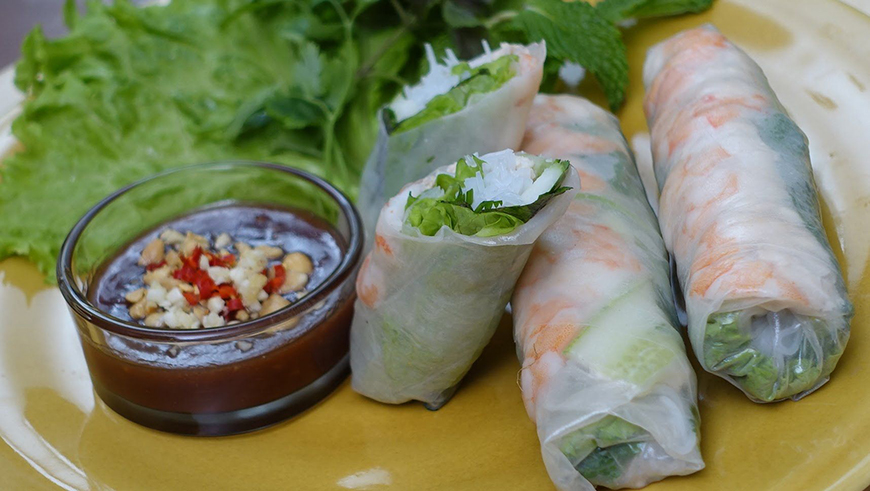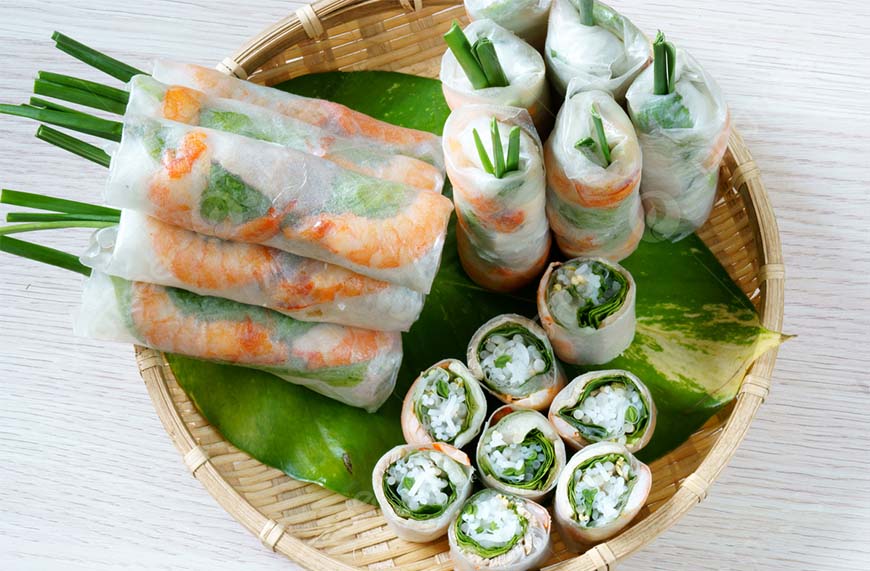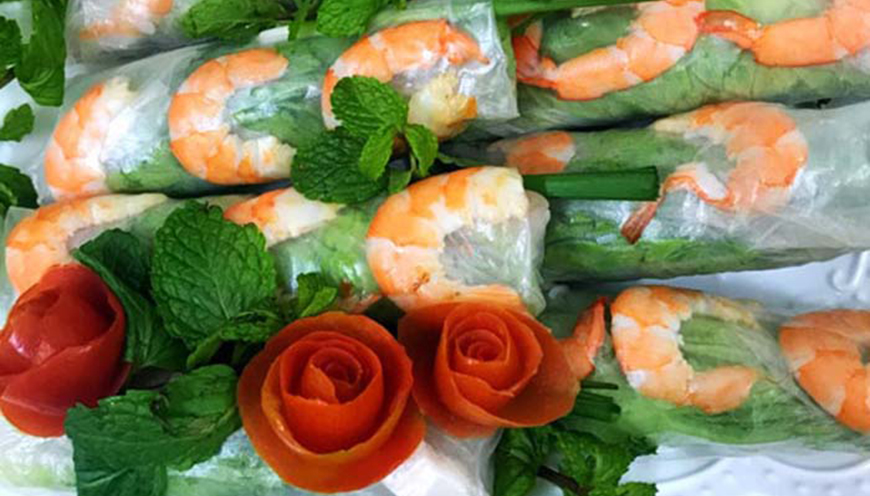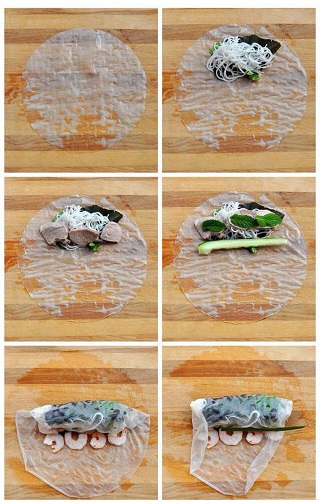Gỏi cuốn, Nem cuốn, or
Vietnamese Spring Roll... Whatever its name, this legendary dish embodies the essence of Vietnamese street food. Delicious, nourishing and accessible, it is a true ode to the flavors and colors of Vietnam.
But beyond its simple appearance,
Goï Cuon hides a rich and fascinating history, nourished – without bad pun - by legends and traditions.
Before we dive into its preparation and enjoy each bite, let’s take the time to discover the secrets of this culinary treasure...

Goi cuon, an ode to the flavors and colors of Vietnam - Photo : Internet
Origins of the Goi Cuon
Goï Cuon, treasure of Vietnamese gastronomy, was not born by chance. Literally meaning «salad in rolls», it is the fruit of a long history and know-how transmitted from generation to generation. Its simple but refined composition reflects the ingenuity and wisdom of Vietnamese ancestors.
A journey through time
Known as "fresh spring rolls", Goï Cuon have been an integral part of Vietnamese cuisine for centuries.
The shadow of the dynasties
Some theories place their origins at the time of the Nguyen dynasty (1802-1945), where they would have been present at royal banquets and important festivals. Other stories go back even further, to the time of the Lý dynasty (1009-1225). Finally, some claim that their birth took place in the villages of the Tonkin Delta (Red River Delta, North Vietnam).
Mystery and uncertainty
In fact, the exact origin of Goi Cuon remains uncertain. But whatever the time of its creation, this dish is a true symbol of Vietnamese culture and a precious heritage to preserve. If we do not really know the exact origin of Goi cuon, several theories clash as to its nassance. Let me tell you the best known.
A royal legacy
According to this theory, the Goï Cuon were invented at the imperial court of the Nguyen dynasty. Their finesse and freshness would have made them a delicacy of choice for royal banquets and special occasions.
A Chinese inspiration
Some culinary historians believe that the Goi cuon derive from Chinese spring scrolls, introduced to Vietnam through trade and cultural exchanges.
A gift from the ancestors
Other stories place the origin of Goï Cuon in the culinary traditions of the villages of northern Vietnam. This simple and nourishing dish would have been prepared by Vietnamese families to celebrate spring and important holidays.
A local evolution
Others claim that the Goi cuon are a Vietnamese adaptation of a popular dish from southern China, the "zòngzi". This version would have been modified over time to use local ingredients and typical Vietnamese preparation techniques.
A popular legend
The Goi cuon were allegedly invented by Vietnamese peasants who were looking for a convenient way to transport their meals into the fields. Another version highlights the ingenuity of Tonkin Delta fishermen who would have used fresh fish and local vegetables to create a tasty and economical dish.

Goi cuon, also known as Vietnamese Spring Rolls - Photo : Internet
Symbolic of the Goi cuon
Goï Cuon is more than just a dish. It is a symbol of happiness, prosperity and luck. Much more than a simple combination of ingredients, it is an invitation to travel, an ode to Vietnamese culture and traditions.
Spring in Vietnam is a season of renewal and freshness. The Goi Cuon, with their light and colorful ingredients, perfectly symbolize this pivotal period. The translucent rice leaf, like a blank canvas, represents purity, while vegetables and meat, like a precious treasure, evoke prosperity and abundance.
The cylindrical shape of the Goï Cuon is not accidental. It recalls the roundness of the moon, a symbol of perfection in Vietnamese culture. The bright and varied colours of the farce celebrate joy and prosperity. Finally, the way of rolling the Goï Cuốn, firmly squeezing the ingredients, symbolizes unity and family cohesion.
Did you know that… Offering Goi cuon to loved ones is considered a gesture of generosity and friendship that expresses the affection and respect we have for others. There is also this legend that tells the story of a young couple who loved each other madly. The young man, poor and humble, could only offer his beloved simple spring rolls. But these rolls, prepared with love and attention, were far more precious than any material gift. They symbolized the sincerity of his feelings and the strength of his love.
Did you know that?
- • Traditionally prepared with ground pork, Goï Cuon are now available in a multitude of variants to satisfy all tastes. Chicken, shrimp, vegetables and even tofu for the vegetarian version, the possibilities are endless!
- • If the name "Goi Cuon" is the best known, note that it will be called "bánh tráng cuốn" or "nem cuốn" according to the regions of Vietnam.
- • I have been told that in some parts of the Two Delta Country, there is an ancient tradition of placing a leaf of lettuce inside the roll to symbolize longevity.
- • One of the most unique aspects of Goi Cuon is its preparation. Indeed, it is customary to roll the rolls yourself at the table. This practice creates an interactive and friendly culinary experience, where each guest can participate in the creation of their own dish.
Goi cuon, a popular dish, a world conquest
The popularity of Goi Cuon is not limited to the borders of Vietnam. Its freshness, flavor and simplicity have made it a dish appreciated worldwide. Whether for a light meal, a refined starter or an exotic aperitif, Goi Cuon adapts to all occasions. Let us add that it is undeniable that simplicity is one of the greatest strengths of Goi Cuon. It requires only simple and inexpensive ingredients, making it accessible to all budgets. This accessibility makes it a popular meal with Vietnamese families, who enjoy it both at parties and celebrations as well as in everyday life.
Goi cuon, a dish with many variations
At the risk of repeating myself (but love doesn’t keep score, right ?), Goi Cuon is not only a simple dish, it’s a real mosaic of flavors and textures. Its composition, far from being fixed, comes in a multitude of variations, reflecting the richness and diversity of Vietnam’s regions and culinary traditions. Indeed, each region of Vietnam has its own interpretation of Goi Cuon, offering a unique exploration of tastes and textures. In the north, the intense flavors of ground pork and aromatic herbs. In the south, fresh shrimp and vegetables dominate, bringing a touch of lightness and freshness.
Goi Cuon is above all a dish celebrating the freshness of the products. The vegetables, picked the same day, are finely chopped and keep all their crunchiness. Aromatic herbs, such as coriander and mint, bring a touch of freshness and fragrance. The accompanying dip plays a crucial role in the harmony of the flavors of Goi Cuon. Traditionally based on nuoc mam, sugar and lime, it can be embellished with chili, garlic and ginger for a touch of exoticism. Its tangy and slightly spicy freshness counterbalances the richness of the toppings and sublimates each bite. The preparation and tasting of Goi cuon is a moment of sharing and conviviality, where each bite is an explosion of flavors and freshness.

Goi cuon, a delicate alchemy between flavours, textures and colours - Photo : Internet
Ready to enjoy spring?
Tie up your aprons and get ready to discover the authentic recipe of Goi Cuon!
Let yourself be guided by the flavors and traditions of Vietnam, and enjoy every moment of this gourmet pleasure.
Note: The trick is to roll the rolls so that they do not break the preparation but do not yield to the first bite: delicately but firmly. An art… Be patient and tenacious!
The authentic recipe of Goi Cuon
Preparation time: about an hour
Ingredients for 4 people
• 12 x 18 cm rice patties
• 12 medium shrimp tails (13/15 gauge)
• 250 g boneless pork loin
• 1 bunch (24 leaves) fresh mint
• 24 Thai basil leaves
• 1 bunch (6 stems) fresh chives
• 2 large handfuls of bean sprouts
• 2 nests of rice vermicelli + 1 tsp of vinegar (optional, this helps maintain the whiteness of the vermicelli after cooking)
• 4 large flexible salad leaves (lettuce or batavia)
• Nuoc mam sauce
• 3/4 bowl Hoi Sin rice sauce
• 3 tablespoons of water
• 2 sugars in pieces
• 2 tablespoons of crushed peanuts
• 1 chilli (to taste)
Ingredients preparation
• Cook the meat in boiling water and let it cool (this can be done a few hours before making the rolls or even the day before).
• Cook the shrimp in boiling water for 2 minutes maximum (otherwise they shrink and the flesh hardens). Immerse them immediately in fresh water, so that the flesh firms up. And it will then be easier to peel them (this operation prevents the flesh from adhering to the shell).
• Meanwhile, wash herbs, soy and salad
• Cut meat into 3 mm thick slices
• Peel the shrimp and cut in half lengthwise
• Cook the noodles like pasta, stirring often. The time depends on the brand, taste the vermicelli and when they are tender, drain them and run them under cold water.
• Prepare the sauce: mix the Nuoc Mam sauce with the juice of a lime, chopped garlic and finely chopped red chili (optional). Add a little sugar to balance the taste.
Shaping of the Goi cuon

Wet two tea towels with warm water.
For each rice cake: run it under warm water and put it on one of the tea towels. A tea towel can put 6 patties. It only takes three minutes for the patties to be ready.
Put the second cloth on top and put the other 6 patties on it.
On the lower center edge, stack in this order:
- A ½ leaf salad
- Two mint leaves side by side
- Two basil leaves side by side
- 3 to 4 soy strands
- The equivalent amount of two fingers of vermicelli
- 1 to 2 pieces of meat depending on the length of your slices
Put the prawns face pink against the patty just behind the pile of ingredients you just formed.
Start by folding the right and left edges.
Then roll it up on itself, wrapping the ingredients so that they seem to fit together. Have the delicate but firm gesture.
Halfway, affix a stem of chives and close the roll.
Divide the sauce among small ramekins and sprinkle with crushed peanuts before serving. Serve the chili pepper separately.
The rolls can be prepared two hours in advance and stored in the refrigerator covered with a wet cloth.
Tips and tricks
• To soften the rice patties more easily, dip them in a bowl of warm water with a little white vinegar.
• Do not overfill the patties for easy rolling.
• For a vegetarian version, replace pork and shrimp with tofu, mushrooms or sautéed vegetables.
• Be creative! You can add other ingredients as you wish, such as grated carrots, cucumbers, green onions, etc. We are moving away from the original recipe, but the idea is (also) to have fun!
Variation for sauce:
Mix nuoc mam sauce, sugar, rice vinegar, lime juice and water in a bowl. Then add a little ginger, chopped garlic and chilli (optional).
Have a good tastings!
More info here :
► The basics of Vietnamese cuisine
► Vietnamese Cuisine, the most popular street foods